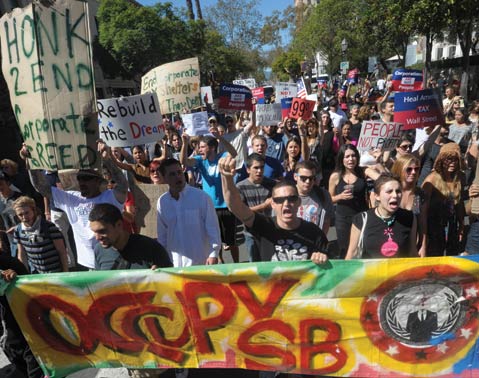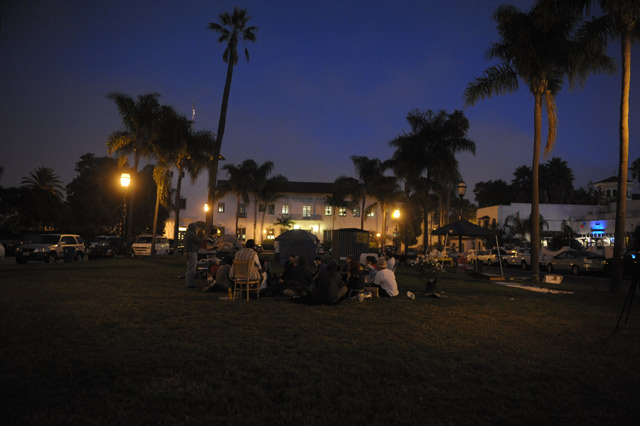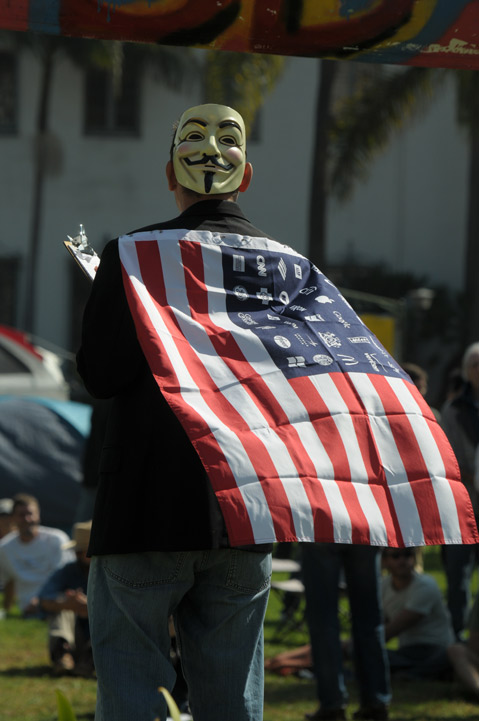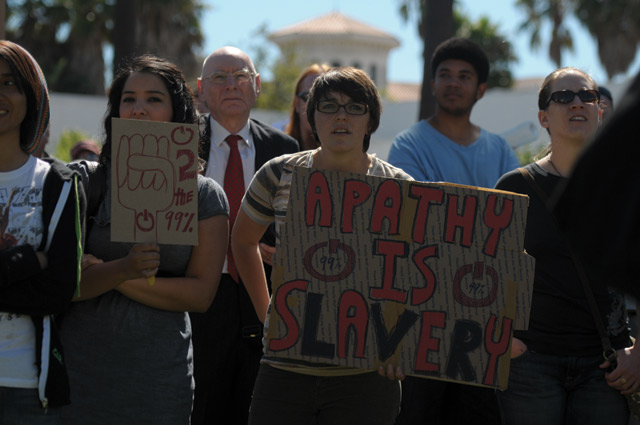This Is Not Your Daddy’s Protest
An Idiot's Guide to Occupy Santa Barbara

Somewhere on State Street between Bank of America and Chase, I realized that marching in a protest rally is a lot like walking. I’ve never demonstrated before, and I wasn’t part of the weekly Occupy Santa Barbara rally to protest, but to report. So I pinballed back and forth between occupiers asking them what they’re so pissed about. While all of the regular court jesters, conspiracy theorists, and semipro activists were on hand, most of the participants didn’t resemble the tie-dyed, flower-power, Vietnam-era washouts and wannabes I associate with these events.
When the more vociferous marchers crowded the windows of bailout benefactors, I fell to the back, where Katie Snyder stood with her 5-month-old son strapped to her torso. She’d just been walking down State Street to get her baby to sleep when she joined the march and started chanting, hoping to set a good example for her son by speaking up against injustice. As we watched the protesters shake their poster board signs, Snyder told me, “I’m part of the 99 percent.”
“We are the 99 percent” — which reminds that just one percent of Americans own nearly half of the country’s wealth — has become the official slogan of the Occupy Wall Street protests, which began on September 17, when hundreds of people took over Zuccotti Park in New York City’s financial district, built a tent city, and started inspiring similar protests around the country. The movement hit Santa Barbara in early October when crowds began occupying De la Guerra Plaza and sleeping in front of City Hall. That resulted in some arrests, but the city has tolerated the daytime occupation, as well as the Saturday protest marches through downtown, which on October 15 drew close to 500 people.
The one I followed along last Saturday was much smaller, but like Occupy Wall Street, the public support only seems to grow, at least on the Internet, as Occupy Santa Barbara’s Facebook page has tallied more than 330,000 hits as of press deadline. Occupiers can discuss, debate, and plan through Facebook, Twitter, and other blogs — free and far-reaching online tools that are being used in the same fashion as they were during the Arab Spring — and the clearinghouse has become the OccupySB.org Web site, where users can post videos of the protests, as well as notes from the daily “General Assembly” meetings. Those experiments in democracy, which go down locally every night in De la Guerra Plaza, are also borrowed from Occupy Wall Street, which ripped them from protest movements in Cairo’s Tahrir Square and Madrid’s Puerto del Sol.
As I shivered through three descending dusks watching a clutch of wide-eyed youth and battle-scarred rabble-rousers stumble their way through General Assembly meetings, I questioned whether I was observing a phenomenon with enough direction to be called a movement. But maybe — like the critics who bash Occupy for lacking identifiable leaders and a list of demands — I was missing the point.
One of the brains behind Occupy Santa Barbara’s technological machine is Alex Luhrman, who also does occasional computer work for this newspaper and has been intensely watching this year’s protest movements both at home and abroad. When I ran the common critiques of Occupy by him, he was quick to argue that action and specific demands aren’t necessarily important, at least not yet. “The state of the problem is so huge that it’s not about coming up with a solution until the problem is discussed,” said Luhrman, explaining that the movement is in the highly important networking stage, with protesters around the country gathering email addresses, creating social media sites, and connecting with each other. That means, said Luhrman, that whenever the time for action arises, people will mobilize immediately, and en masse.

Test Tube for Democracy
Despite the national storyline that Occupy protesters are unfocused and disorganized, three distinct grievances emerge when you talk to the protesters individually: money in politics, wealth disparity, and a lack of democracy. Over and over, I’ve heard complaints about last year’s Supreme Court decision that allowed corporations to dump even more money into elections, anger that the bankers who engaged in reckless speculation have avoided punishment but been rewarded with bailouts, and concern that politicians care more about moneyed interests than their constituents.
These issues are aired during the nightly General Assembly meetings, where protesters attempt to harness the ideals of democracy that they feel are forgotten. To do so, they use hand signs to signal their desire to speak, as well as their approval or disapproval of other speakers’ points. Participants are encouraged to put their talents to use by joining one of the many committees — which range from communication, finance, research, and legal to synthesis (which ties into the larger movement) and funk (whose purpose remains a mystery to me) — or starting a new one. The assemblies can grow unwieldy as occupiers get sidetracked by philosophical quandaries, tangential discussions, and uncertainties about proper procedure, and, as they approach their two-and-a-half-hour time limit, they tend to make even the most laborious City Council hearing seem concise.
“People feel like they don’t have a voice in the system.”
But some folks, like Mariah Messer, who attends the meetings after teaching adult-education classes at Santa Barbara City College, are inspired by the community-building aspect of the process. Others — such as one man who didn’t want to be identified, worried that parents of children at the elementary school where he works might be bothered by his involvement — believe the General Assembly offers a “brand-new radically democratic movement.” And that’s a welcome change to him and others who feel their votes no longer count, for he explained, “People feel like they don’t have a voice in the system.”
Altogether, this brand of discontent is a reflection of a moribund economy and gridlocked political system, but the framing of Occupy as a struggle between a teeming proletariat and a small, powerful ruling class sounds like the stuff of a third-world revolution rather than 21st-century America. It’s hard to ignore, though, that as wealth disparity continues to grow nationally, the problem is even more acute in Santa Barbara. According to the census, even as California’s population grew 10 percent from 2000 to 2010, the city’s population dropped by 4.2 percent, as the high cost of living squeezed out families and made the city’s population much older than it is across the state and country. Income here is slightly higher, but home prices are more than double the state average, opposing forces that tend to push out the middle class. As such, Occupy Santa Barbara might even make more sense than similar movements in less moneyed areas.
But can such a movement actually effect change, whether on Wall Street or State Street? John Foran, a UCSB sociology professor, believes so, explaining that Occupy has a much broader appeal than, say, a left-wing Tea Party movement. Drawing a line from the Zapatista rebels in Mexico through the Arab Spring to the Occupy protests, Foran explained to me that, while radical democracy can lead to radical chaos, the recent Egyptian example illustrates that, with broad social consensus, it can lead to real revolution. Although he can rattle off a laundry list of issues that he hopes the protests will eventually address, Foran sees no immediate need for Occupy to take up an explicit political platform. “Concentration of wealth in this country is the problem,” he said. “Let’s get people to buy into that message.”
Leaderless Revolution vs. City Hall

On my first night embedded with the protesters on De la Guerra Plaza, Wesley Birch, a scraggly twenty-something from Carpinteria with wavy brown hair just long enough to pull into a ponytail, warned me, “If anyone says they speak for the movement, don’t believe them. They don’t.” In one sense, he’s right: Both Occupy Wall Street and Occupy Santa Barbara can be traced back to online catalysts, but the five minutes it takes to make a Facebook page doesn’t really amount to central planning. But he’s also wrong, in that the Occupy Wall Street movement was inspired by calls to action from the Canadian anti-consumerist group Adbusters and that, in Santa Barbara, a few faces do become a bit more familiar than others when hanging around De la Guerra Plaza.
One of those faces belongs to Marshall Getto, who disavows any leadership role but is clearly a major player in the area and travels by bus from his job as a data systems analyst for ABC-CLIO in Goleta to attend the assemblies. “It is amazing that a bunch of strangers could put this together in less than two days,” said Getto, who was inspired to protest while watching live Web footage of Occupy Wall Street protesters marching across the Brooklyn Bridge. He saw 700 of them being arrested in real time and was aghast when none of the major news outlets publicized the event.
While beards and tattoos abound at the General Assembly, Getto is clean-cut. He shows up wearing dress pants and Gordon Gekko-like hair. He also speaks with a deep voice fit for a baseball announcer, a natural advantage when addressing audiences. Though he’s active in the Santa Barbara Democratic Party — his roommate is party chair Daraka Larimore-Hall — Getto claims he does not want Occupy Santa Barbara to get co-opted by either a political party or, for that matter, any other interest group that has lent support.
Getto’s sharper image also plays a moderating, perhaps even sobering counterweight to some of Occupy Santa Barbara’s firebrands, such as SBCC student Robert Villegas — who calls himself Fire Penguin Disco Panda — and Justin Kennedy, an electrician who heckles City Attorney Steve Wiley when he leaves work for the day and heads to his car. Though Getto isn’t heckling Wiley himself, he has questioned City Hall’s response to the protests, which have involved arrests and citations, even asking during a recent online City Council candidate forum, “Do you believe that Santa Barbara residents have the right to exercise their First Amendment rights under the U.S. Constitution to protest peacefully in De la Guerra Plaza?”
To the occupiers, Wiley has become persona non grata. They believe he is the mastermind behind their repression, for he was the one who advised City Hall to continue issuing citations to the handful of protestors who camp overnight in the plaza. “I don’t pick and choose what laws to enforce,” he explained. “If we did, we’d get accused of favorable treatment.”
But some other cities have decided to ignore ordinances to accommodate Occupy campers, and in Los Angeles, the City Council even made a show of touring their downtown occupation to express solidarity with the protesters. With a conservative-leaning majority, it’s unlikely that Santa Barbara’s City Council will amend the ordinance that prevents people from gathering in the plaza after 10 p.m., and Wiley believes that the other cities will soon regret their decisions, as temporary tent cities become permanent homeless encampments.
But occupiers like Getto, Kennedy, and Fire Penguin Disco Panda continue to claim that their rights to assembly and free speech are being trampled, so they’ve contacted the ACLU and lobbied the City Council to have their charges dropped. In the bigger picture, though, the whining about police oppression in De la Guerra Plaza may be more of a distraction than just sticking to the movement’s main message.
Back at the march last Saturday, as we made our way toward Wells Fargo, that simplistic yet effective chorus was once again reiterated to me by Katie Mullen, an unemployed veterinarian who was pushing a bicycle adorned with a sign proclaiming “Corporations Are Not People.” When I asked her why she’d become part of Occupy Santa Barbara, she did not hesitate to answer: “So much money is in the hands of so few.”

What’s Next?
As of now, the Occupy Santa Barbara General Assembly is maintaining its weekly march on State Street every Saturday at noon. (That did have the Thrill the World crew worried about whether there would be room for their annual “Thriller” flash-mob dance in De la Guerra Plaza this weekend, so they relocated to the S.B. Courthouse Sunken Gardens, but that’s another story.) The next nationally coordinated action is planned for November 5, Bank Transfer Day, when citizens are urged to close their accounts at large banks and transfer their money to local credit unions. Steve Phillips, a computer programmer who says he owes $100,000 in student loans, is trying to convince eight area credit unions to sponsor advertisements for the event.
In the meantime, even if the rallies dissipate and true believers vacate De la Guerra Plaza, the Occupy protests will continue to burn white-hot on the Internet in the weeks to come. It’s possible that the movement is becoming less dense and more dispersed, but it’s not slowing down at all.
That’s what Michael Schirzer, a fourth-year history major at UCSB, would like to believe. He spent last Friday signing up 100 students to begin an Occupy Isla Vista. “This is just the beginning,” said Schirzer. “I think this is the start of something real big.”
4•1•1
Occupy Santa Barbara will be hosting a public forum at De la Guerra Plaza this Saturday, October 29, from 2-4 p.m. Current city councilmembers and running candidates are invited to attend and provide official statements. For more information, visit OccupySB.org.



